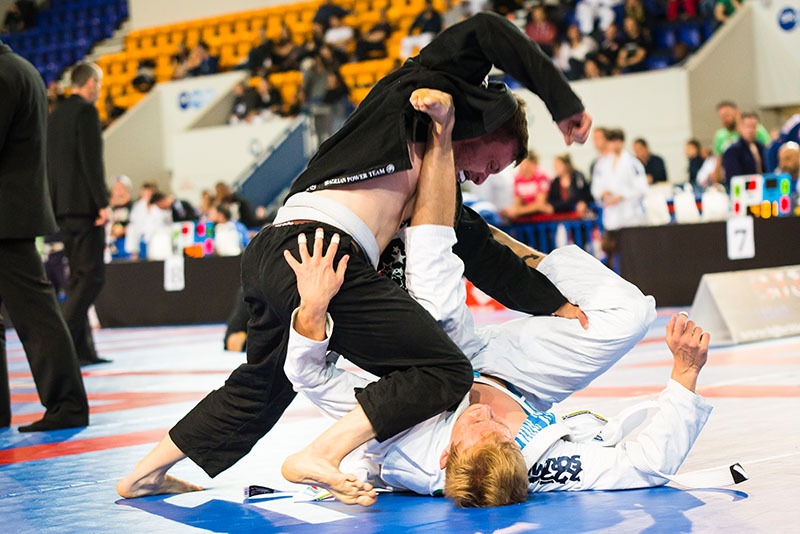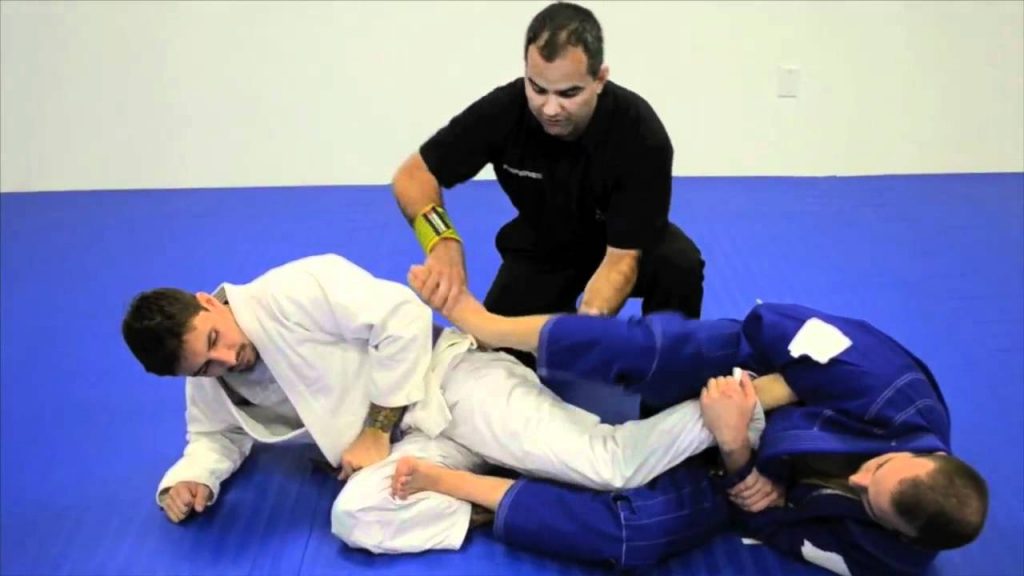
Hey there IBJJF competitor! I guess since you already have a few tournaments under your belt, you do not need this article. Or do you? This is a piece for both the novice competitor and the seasoned grappler too. The world of BJJ rules, even under one organization is so vast, there’s no way of explaining it without a book. Actually, there’s a book out there called the IBJJF rulebook, which usually only makes things even more complicated. Today, we’ll go over the nuts and bolts of BJJ rules fro IBJJF competition. We won’t cover everything, but we’ll try to make sense of the most basic things. That way you won’t have to be confused or yell at the referee next time something “unexplainable ” happens at a competition.
The IJJF or International Brazilian Jiu-Jitsu Federation is the largest global organization in the grappling world. It is a product of Gracie Barra, the largest BJJ association of academies run by Carlos Gracie Jr. himself. The IBJJF has a truly elaborate system of rules which is not really subject to much change. Over the years, there haven’t been any major changes to the IBJJF rulebook. That said, the influence of the IBJJF is so widespread, that most local tournaments, at least in the Gi, go by their BJJ rules. That means that wherever you choose to compete, apart from professional submission-only events, you’ll be grappling under the same rules. Even the world’s second largest organization the UAJJF has the same rules when it comes to competition.
So, what should you know about BJJ rules? How can we sum up a whole book of rules in just one article? Well, we’re going to categorize things, of course. in order to do so, we’re going to run over a usual IBJJF tournament as if competing. We’ll cover everything in the process, from signing up to what you do on the mats. You’re going to find some useful information for sure, even if you already know all the IBJJF rules. Knowing the BJJ rules you’re competing under means that you can use the system to ensure you get an undisputed victory, even if it is by the notorious advantages.
The Basics Of IBJJF Tournaments
Signing up for an IBJJF tournament is done online. You need to create an account and follow the instructions. Make sure you sign up on time though, as registration closes a few days before a tournament.

Next up it’s the duration of your matches. Different belt levels are grappling for different time periods. White belts have 5-minute bots, blue belts six, purple seven, brown 8 and ten-minute matches are reserved for black belts. But, there’s a catch to this as well. Bout duration changes (shortens) with each age category. The above rules are for the adult division, meaning people from 18 to 29. Everyone above thirty is in the Master’s divisions where bouts get shorter as the age gets higher.
Finally, you need to know that your Gi and belt need to be in pristine condition and with the appropriate length in order to even be allowed to step on the mats.
Technical Aspects Of BJJ Rules
the only goal of a BJJ match is, of course, to win. Doing so in IBJJF matches comes in a few varieties. According to BJJ rules, you can either win by submission, points, advantages or a decision. Now, since submissions are clear to everyone, we’re not going to linger on that point log. It’s enough to say that any choke or joint lock you can successfully apply, is going to bring you victory. If you can’t submit your opponent, it’s down to other methods.
I’m going to dumb down the point system as much as I can. In order to win you need more points than our opponent. You get points based on the positions you acquire. A successful takedown or a sweep bring you 2 points. Passing the guard (not getting to side control from another position) brings you 3 points. Knee on belly is also a two-pointer, while mount and back position is the best to go for, with four points each. Just remember that reversing someone from bottom side control or mount is not a sweep, and you’ll get no points for it.
Advantages are the dark spot of BJJ rules. Most people do not understand them and losing by one is definitely something you do not want to do. If you attempted a submission or got a sweep but you couldn’t hold your opponent for three seconds, you get no points, but you get an advantage. Advantages can see out a match so they’re an important piece of the puzzle. However you can have all the advantages in the world, but if the opponent has just 1 point, they win.
Finally, a referee decision is going to determine the outcome if everything is equal.
Illegal Moves
Now that you know all the ways to win an IBJJF match let’s look at how not to lose. JJ rules in terms of illegal techniques and positions are numerous, and you need to know them as good as these that can bring you victory. The basic idea is that some positions are too dangerous ate certain belt levels (or all of them). For example, heel hooks are illegal for everyone, regardless of belt level. Wristlocks can be done from blue belt upwards, while knee bars and toe hold enter the game from the brown belt.

Neck cranks are also illegal at all belt levels. While you can get away with Japanese neckties or cranks from a rear naked choke, it’s best if you avoid them completely.
Takedowns are another major aspect of BJJ rules for competitors. In Jiu-Jitsu you can’t do dangerous takedowns like the scissor takedown or slams. These are all ground for immediate DQ.
Jose Varella knows exactly which leg locks are allowed under the IBJJF banner. Thanks to his “IBJJF Legal Footlocks” you can now also bring an end to all the confusion. Get this DVD fast!
A Practical Blueprint for the Journey Through Brazilian Jiu-Jitsu


![Darce Choke Encyclopedia – Origins, Mechanics and Variations [2024] BJJ, choke, Brabo, BJJ Darce Choke, D'arce Choke, Darce BJJ Choke](https://bjj-world.com/wp-content/uploads/2017/11/JungPoirierLeeYahoo-218x150.jpg)










![Best Marcelo Garcia Techniques by Team Marcelo Garcia DVD Review [2025] Best Marcelo Garcia Techniques by Team Marcelo Garcia DVD Review](https://bjj-world.com/wp-content/uploads/2025/02/best-marcelo-garcia-techniques-dvd-review-218x150.png)
![Forging The De La Riva Guard Giancarlo Bodoni DVD Review [2025]](https://bjj-world.com/wp-content/uploads/2025/02/de-la-riva-guard-giancarlo-bodoni-dvd-review-218x150.png)

![Breaking Their Guard Mikey Musumeci DVD Review [2025] Breaking Their Guard Mikey Musumeci DVD Review](https://bjj-world.com/wp-content/uploads/2025/02/breaking-their-guard-mikey-musumeci-dvd-review-218x150.png)

![Collar Sleeve Guard Mikey Musumeci DVD Review [2024] Collar Sleeve Guard Mikey Musumeci DVD Review](https://bjj-world.com/wp-content/uploads/2024/12/collar-sleeve-guard-mikey-musumeci-dvd-review-324x235.png)
![Higher Tripod Passing Craig Jones DVD Review [2025] Higher Tripod Passing Craig Jones DVD Review](https://bjj-world.com/wp-content/uploads/2025/02/higher-tripod-passing-craig-jones-dvd-review-100x70.png)



![Slay The Wrestle Up Guard Nick Rodriguez DVD Review [2024] Slay The Wrestle Up Guard Nick Rodriguez DVD Review](https://bjj-world.com/wp-content/uploads/2024/12/slay-the-wrestle-up-guard-nick-rodriguez-dvd-review-100x70.png)



![Neil Melanson DVD Bundle Review: Filthy Brutal No Good Attacks [2024] Neil Melanson DVD Bundle Review: Filthy Brutal No Good Attacks](https://bjj-world.com/wp-content/uploads/2024/10/neil-melanson-dvd-bundle-review-filthy-attacks-100x70.png)



![Dubious De La Riva Dominique Bell DVD Review [2024] Dubious De La Riva Dominique Bell DVD Review](https://bjj-world.com/wp-content/uploads/2024/10/dubious-de-la-riva-dominique-bell-dvd-review-100x70.png)
![Countering Triangles And Omoplatas Adam Mazin DVD Review [2024] Countering Triangles And Omoplatas Adam Mazin DVD Review](https://bjj-world.com/wp-content/uploads/2024/10/countering-triangles-and-omoplatas-adam-mazin-dvd-REVIEW-100x70.png)
![Grappling Takedown Dominance Brandon Ruiz DVD Review [2025] Grappling Takedown Dominance Brandon Ruiz DVD Review](https://bjj-world.com/wp-content/uploads/2025/01/grappling-takedown-dominance-brandon-ruiz-dvd-review-100x70.png)

![Crush The Guard Vagner Rocha DVD Review [2024] Crush The Guard Vagner Rocha DVD Review](https://bjj-world.com/wp-content/uploads/2024/10/crush-the-guard-vagner-rocha-dvd-review-100x70.png)


![Darces From Everywhere Kade and Tye Ruotolo DVD Review [2024] Darces From Everywhere Kade and Tye Ruotolo DVD Review](https://bjj-world.com/wp-content/uploads/2024/10/darces-from-everywhere-kade-and-tye-ruotolo-dvd-cover-100x70.png)
![Darragh O’Conaill Crucifix Encyclopedia DVD Review [2024] Darragh O'Conaill Crucifix Encyclopedia DVD Review](https://bjj-world.com/wp-content/uploads/2024/10/darragh-oconaill-crucifix-encyclopedia-dvd-review-100x70.png)


![Jett Thompson Master Ankle and Aoki Lock DVD Review [2024] Jett Thompson Master Ankle and Aoki Lock DVD Review](https://bjj-world.com/wp-content/uploads/2024/09/jett-thompson-master-ankle-and-aoki-lock-dvd-review-100x70.png)
![Jeff Glover Deep Half Revolution DVD Bundle Review [2024] Jeff Glover Deep Half Revolution DVD Bundle Review](https://bjj-world.com/wp-content/uploads/2024/10/jeff-glover-deep-half-revolution-dvd-bundle-review-100x70.png)

![Front Headlock and Turtle Escapes Brian Glick DVD Review [2024] Front Headlock and Turtle Escapes Brian Glick DVD Review](https://bjj-world.com/wp-content/uploads/2024/11/headlock-and-turtle-escapes-brian-glick-dvd-review-100x70.png)

